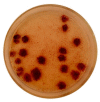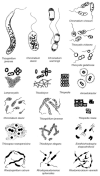Molecular Physiology of Anaerobic Phototrophic Purple and Green Sulfur Bacteria - PubMed (original) (raw)
Review
Molecular Physiology of Anaerobic Phototrophic Purple and Green Sulfur Bacteria
Ivan Kushkevych et al. Int J Mol Sci. 2021.
Abstract
There are two main types of bacterial photosynthesis: oxygenic (cyanobacteria) and anoxygenic (sulfur and non-sulfur phototrophs). Molecular mechanisms of photosynthesis in the phototrophic microorganisms can differ and depend on their location and pigments in the cells. This paper describes bacteria capable of molecular oxidizing hydrogen sulfide, specifically the families Chromatiaceae and Chlorobiaceae, also known as purple and green sulfur bacteria in the process of anoxygenic photosynthesis. Further, it analyzes certain important physiological processes, especially those which are characteristic for these bacterial families. Primarily, the molecular metabolism of sulfur, which oxidizes hydrogen sulfide to elementary molecular sulfur, as well as photosynthetic processes taking place inside of cells are presented. Particular attention is paid to the description of the molecular structure of the photosynthetic apparatus in these two families of phototrophs. Moreover, some of their molecular biotechnological perspectives are discussed.
Keywords: anaerobes; anoxygenic bacteria; detoxification; hydrogen sulfide; molecular mechanisms of photosynthesis; water environment.
Conflict of interest statement
The authors declare no conflict of interest.
Figures
Figure 1
The colonies of purple sulfur bacteria of Lamprocystis genus [11].
Figure 2
The morphological diversity of some phototrophic purple bacteria [11].
Figure 3
Schematic comparison of the dsr gene region arrangement found in Allochromatium vinosum with another species of phototrophs (data from Frigaard and Dahl, 2009 [46]).
Figure 4
Schematic distribution of Dsr proteins in the Allochromatium vinosum cell. This scheme is based on sequence analysis of dsr coding genes and on available biochemical information (data from Dahl, 2008 [66]).
Figure 5
Model of a possible arrangement of a photosynthetic unit (LH1 and LH2 are localized around the reaction center (RC). (a) LH1 + RC Rhodospirillum rubrum growing at high light inten-sities, (b) LH1 + RC + LH2 Rhodopseudomonas palustris growing at low light intensities, (c) LH1 + RC + LH2 Rhodopseudomonas palustris growing at high light intensities, (d) LH1 + RC + LH2 Al-lochromatium minutissimum growing at low light intensities (data from Solovev and Erokhin, 2008 [86]).
Figure 6
Schematic structure of the photosynthetic apparatus of green sulfur bacteria (the scheme modified from Dostál, 2014 [91].
Similar articles
- Anoxygenic photosynthesis with emphasis on green sulfur bacteria and a perspective for hydrogen sulfide detoxification of anoxic environments.
Kushkevych I, Procházka V, Vítězová M, Dordević D, Abd El-Salam M, Rittmann SKR. Kushkevych I, et al. Front Microbiol. 2024 Jul 11;15:1417714. doi: 10.3389/fmicb.2024.1417714. eCollection 2024. Front Microbiol. 2024. PMID: 39056005 Free PMC article. Review. - Long-term population dynamics of phototrophic sulfur bacteria in the chemocline of Lake Cadagno, Switzerland.
Tonolla M, Peduzzi R, Hahn D. Tonolla M, et al. Appl Environ Microbiol. 2005 Jul;71(7):3544-50. doi: 10.1128/AEM.71.7.3544-3550.2005. Appl Environ Microbiol. 2005. PMID: 16000760 Free PMC article. - Physiology of phototrophic iron(II)-oxidizing bacteria: implications for modern and ancient environments.
Hegler F, Posth NR, Jiang J, Kappler A. Hegler F, et al. FEMS Microbiol Ecol. 2008 Nov;66(2):250-60. doi: 10.1111/j.1574-6941.2008.00592.x. Epub 2008 Sep 22. FEMS Microbiol Ecol. 2008. PMID: 18811650 - Vertical structure of the bacterial diversity in meromictic Fayetteville Green Lake.
Block KR, O'Brien JM, Edwards WJ, Marnocha CL. Block KR, et al. Microbiologyopen. 2021 Aug;10(4):e1228. doi: 10.1002/mbo3.1228. Microbiologyopen. 2021. PMID: 34459548 Free PMC article. - Anoxygenic Photosynthesis in Photolithotrophic Sulfur Bacteria and Their Role in Detoxication of Hydrogen Sulfide.
Kushkevych I, Bosáková V, Vítězová M, Rittmann SKR. Kushkevych I, et al. Antioxidants (Basel). 2021 May 22;10(6):829. doi: 10.3390/antiox10060829. Antioxidants (Basel). 2021. PMID: 34067364 Free PMC article. Review.
Cited by
- Characterization of the First Cultured Representative of "Candidatus Thermofonsia" Clade 2 within Chloroflexi Reveals Its Phototrophic Lifestyle.
Zheng R, Cai R, Wang C, Liu R, Sun C. Zheng R, et al. mBio. 2022 Apr 26;13(2):e0028722. doi: 10.1128/mbio.00287-22. Epub 2022 Mar 1. mBio. 2022. PMID: 35229635 Free PMC article. - Electron Transfer in the Biogeochemical Sulfur Cycle.
Zhuang X, Wang S, Wu S. Zhuang X, et al. Life (Basel). 2024 May 6;14(5):591. doi: 10.3390/life14050591. Life (Basel). 2024. PMID: 38792612 Free PMC article. Review. - Anoxygenic photosynthesis with emphasis on green sulfur bacteria and a perspective for hydrogen sulfide detoxification of anoxic environments.
Kushkevych I, Procházka V, Vítězová M, Dordević D, Abd El-Salam M, Rittmann SKR. Kushkevych I, et al. Front Microbiol. 2024 Jul 11;15:1417714. doi: 10.3389/fmicb.2024.1417714. eCollection 2024. Front Microbiol. 2024. PMID: 39056005 Free PMC article. Review.
References
- Overmann J. The Family Chlorobiaceae. In: Dworkin M., Falkow S., Rosenberg E., Schleifer K.-H., Stackebrandt E., editors. The Prokaryotes. Springer; New York, NY, USA: 2006. pp. 359–378.
- Pfennig N. Green sulfur bacteria: Archaeobacteria, Cyanobacteria, and Remaining Gram-Negative Bacteria. In: Staley J.T., Bryant M.P., Pfennig N., Holt J.C., editors. Bergey’s Manual of Systematic Bacteriology. Williams & Wilkins; Baltimore, MD, USA: 1989. pp. 1682–1697.
- Imhoff J.F. Taxonomy and Physiology of Phototrophic Purple Bacteria and Green Sulfur Bacteria. In: Blankenship R.E., Madigan M.T., Bauer C.E., editors. Anoxygenic Photosynthetic Bacteria. Volume 2. Kluwer Academic Publishers; Dordrecht, The Netherlands: 2004. pp. 1–15. (Advances in Photosynthesis and Respiration).
Publication types
MeSH terms
Substances
Grants and funding
- Grant Agency of Masaryk University (MUNI/A/1425/2020)/Masarykova Univerzita
- János Bolyai Research Scholarship (BO/00144/20/5) of the Hungarian Academy of Sciences/Magyar Tudományos Akadémia
- ÚNKP-20-5-SZTE-330 New National Excellence Program of the Ministry for Innovation and Technology from the source of the National Research, Development and Innovation Fund/Emberi Eroforrások Minisztériuma
LinkOut - more resources
Full Text Sources





